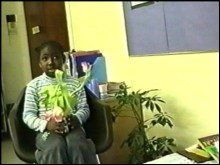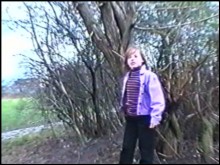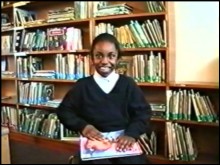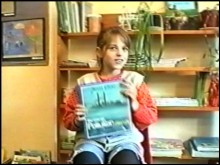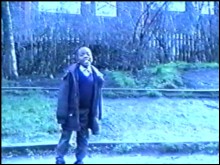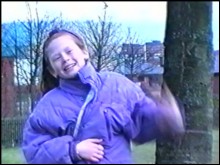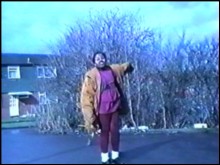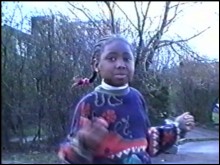Centre for Creative Media Research > Video Critical
Little London Primary School: Making the video
|
|
In stark contrast to the Royal Park group's initial response, these children appeared very excited to be doing something on the environment - even before they knew it was a video activity - and gave a very enthusiastic response when asked if they found work on the environment to be interesting. They had studied the environment in school previously, mostly in relation to litter. They were aware of problems such as pollution, and the advantages of recycling, but did not seem to know about acid rain, or the ozone layer. Asked for a definition of the environment, Celie suggested that it is 'everything', 'everything around us'. As for whether they were worried about environmental problems, the answer was generally no. Asked what they would do when they're older if the problems have got worse: 'Then we'll go somewhere else'. This group approached even the first week's 'practice' video presentation with some enterprise; for example, when invited to talk spontaneously on their chosen subjects, they decided that the proper way to do it was to write scripts. They consequently all sat down and started writing. In addition, most of them chose to talk about things which were related to the environment even though they had not particularly been asked to - Mariam on her favourite tulips, Vicky on recycling, Deneika on flowers, and Celie spoke about animals, 'particularly the animals in the sea who get polluted from the oil spills, like seals and sea birds', and 'endangered animals like tigers, polar bears, gorillas, and pandas'. In the second week, the children produced a substantial amount of material around the school. Being aged only seven and eight seemed to make them, if anything, less reticent about talking at length to the camera. This also meant, however, that they were less good at keeping quiet when not on camera (at one memorable point, Josiah, who was operating the camera, yelled into the microphone 'I want to go to the toilet', and ran off). The children were also able to interview each other on camera comfortably. In the remaining four weeks, whilst the appeal of running around and in particular, for this group, dancing (including some imitation of rather thrusting dances from Top of the Pops) remained strong, the children kept to an environment-related agenda with little need for reminders. Indeed, they produced more unprompted surprises than most groups, as seen in Deneika's enthusiasm for Africa, coupled with an awareness of racism in Britain, and Vicky and Mariam's ability to talk about almost anything at some length. Significantly, without being told to, the children performed for the camera in a way which anticipated an audience of others, asking the 'viewers' rhetorical questions, wishing them well, and signposting their presentations (almost all of which were prefaced with 'Hello, my name is ... and I am going to be talking about ...', and closed with 'And that is the end of my story'). They also captured interesting visual material on tape, such as a broad range of scenery, movement, stepping into shot, their ubiquitous dancing, and minor gymnastics. The children also seemed aware of the opportunity for individual expression, so that, for example, when one child was suggesting words to Josiah, Celie hissed 'Don't tell him what to say' - not to deny Josiah assistance, but in favour of letting him express things himself. The following exchange, from the final week where the children interviewed each other on camera, shows how the children had - on the whole - remained focused upon the aims of the project:
Mariam, a working-class Black girl aged seven, was able to speak at particular length to the camera, and rather than being repetitive or with little point, her utterances were often surprisingly complex. In the following example, Mariam speaks of the excitement and variety of environmental video work with an enthusiasm and scope which threatens to reach beyond her basic language ability, and which was accompanied by many expressive gestures:
The ideas about the 'everywhereness' of the environment at the heart of this speech are ones which Mariam has thought of and developed herself, as far as can be gathered, and they are expressed in her own terms. Whilst not conforming to the highest adult standards of clear presentation, her speech reflects an environmental awareness and enthusiasm which was not so evident in most of the other, older children in this study. Summary This group were particularly enthusiastic about 'the environment', as an abstract term, when the topic was first mentioned to them - going so far as to cheer 'hurray!' and show tangible excitement. The video-making process did not show this passionate response to be false, exactly, but did reveal that the zeal related to the term 'the environment' was, to an extent, superficial. Concern about specific issues - notably litter, pollution and wildlife - seemed real enough, but generally did not appear to have extended to broader issues, or a determination necessarily to do anything about the problems. Given the children's age, however, this lack of generalisation may be entirely natural, and their ability to interpret 'environment' in varied ways for the video production was impressive. Certainly, some concern for the environment was demonstrated by each of the children. Mariam, in particular, whose background was no different to the other children, showed an awareness of the environment which seemed to have been enhanced by the video project, such that she could produce quite eloquent statements on the subject by the final week. In all, the quality of the video work produced by these seven year olds in a disadvantaged school was notably high. |
![]()
The text and images on this site are by David Gauntlett, © 1997, 2004.
Back to > Video Critical home.

